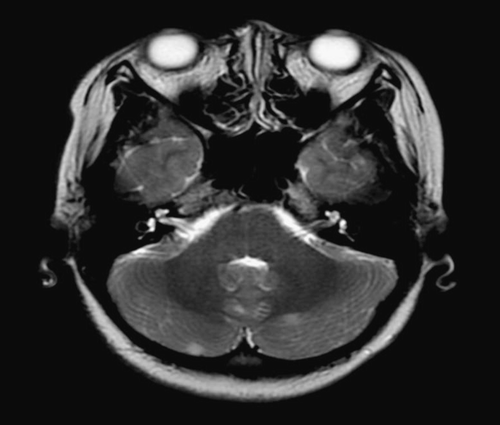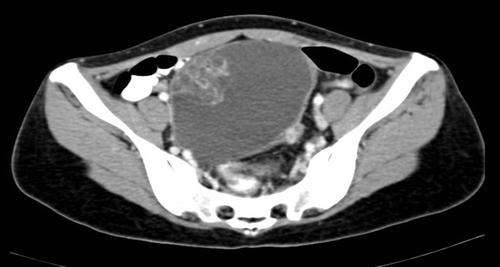Paraneoplastic encephalitis associated with ovarian teratomas and antibodies to the N-methyl-D-aspartate receptor (NMDA) is a recently described phenomenon and resection of the tumour appears significant in achieving sustained neurological recovery Citation[1]. We describe two patients who presented with paraneoplastic encephalitis associated with immature teratomas and discuss the role of chemotherapy in the treatment of this condition.
The first patient was a 15-year-old girl who presented with lower abdominal pain. A CT scan of her pelvis revealed bilateral ovarian masses suggestive of teratomas. These were resected and histology of the left ovarian tumour revealed a grade (2/3) immature ovarian teratoma and the right ovarian cyst had features suggestive of a benign cystic teratoma. With further omental foci of immature teratoma she had a final pathologic stage of IIIA. Twenty-five days post operatively, she began to exhibit several neuro-psychiatric symptoms which include marked short-term memory loss, paranoid psychosis, agitation, catatonia and myoclonic jerks. No organic cause was found to explain her symptoms; extensive metabolic and imaging studies were normal, serum anti-neuronal antibodies (anti-Hu, anti-Yo and anti-Ri) were negative and an EEG done was unremarkable. After failing treatment with anti-psychotic agents, she was started on standard BEP (bleomycin, etoposide, cisplatin) chemotherapy; 14 days after her symptoms began. Two weeks after initiation of chemotherapy her paranoid psychosis resolved. Six weeks later and after completion of three cycles of BEP, her memory returned to normal and she recovered completely.
The second patient was a 24-year-old woman who presented with vomiting and diarrhoea preceding fever, fits and altered mental status. On examination, she had gaze-evoked nystagmus and dystonia. She was also seen with intermittent eye deviation and version to the right associated with right upper limb rigidity and clenching of her fist. She would shout, speak incomprehensibly and she would not respond appropriately to external verbal or visual cues. CSF examination revealed leukocyte pleocytosis, with a nucleated cell count of 14/ul (95% lymphocytes, 5% monocytes, 0% neutrophils); CSF glucose was 3.9 mmol/L with a blood glucose level of 5.4 mmol/L; CSF protein was within normal range. Microbiological assessment of CSF for bacteria, mycobacterium, fungi and viruses were negative and MRI scans of the brain revealed several small T2 hyperintense foci in bilateral cerebellar hemispheres (). The patient was treated empirically for bacterial and herpes simplex encephalitis and in view of her failure to respond to the initial antibiotic regimen, she was also treated for tuberculous meningoencephalitis. In search of a paraneoplastic cause to explain her symptoms, a CT scan of her thorax, abdomen and pelvis was performed. This revealed a 10.8 by 9.7 by 8.5 cm cystic lesion suggestive of a left-sided ovarian teratoma (). Examination of the patient's serum for paraneoplastic markers (anti-Hu, anti-Yo and anti-Ri) was negative. Immunological characterisation of her serum and CSF demonstrated the presence of anti-NMDA receptor autoantibodies. She underwent a resection of the left-sided teratoma () and intra-operatively, a right ovarian cyst was seen and removed. Histology revealed a grade (3/3) immature teratoma and a mature teratoma respectively with a final pathologic stage of IA. Her neuropsychiatric symptoms failed to abate despite surgery and a course of intravenous immunoglobulins. Fourteen days post-operatively, she was started on adjuvant chemotherapy with a standard chemotherapeutic regime of BEP, receiving a total of three cycles. Her dystonia became less prominent rapidly after initiation of her first cycle, but it was only after 20 days after commencement of chemotherapy that she regained orientation and was able to answer questions in a relevant and appropriate manner. She returned to work four months after completion of chemotherapy.
These two cases highlight the role of chemotherapy as an adjunct to surgery in a multimodality approach to paraneoplastic encephalitis associated with teratoma. In the first patient, the temporal association is definitive where neuropsychiatric symptoms only developed after the teratomas were resected. These symptoms resolved completely following chemotherapy. Given that tumour foci were identified on the omentum and in the peritoneal fluid, it is conceivable there may have been residual disease after surgery resulting in a delayed onset of encephalitis. This would further support the role of chemotherapy as an adjunct to surgery. In the second patient, since both surgery and intravenous immunoglobulin was administered prior to chemotherapy, one cannot exclude the possibility that her improvement may have represented a delayed effect of treatment. However, a strong temporal association between initiation of chemotherapy and symptom improvement was noted.
In a review of patients reported to have paraneoplastic encephalitis associated with immature ovarian teratomas in the English literature (), only three of the ten patients received chemotherapy, with a fourth receiving cyclophosphamide only Citation[1–6]. The grade and stage of the disease as well as the details of treatment were however not reported for all ten patients so it is unclear whether chemotherapy would have been recommended Citation[7], Citation[8]. The current difficulty in establishing ideal treatment modalities lies in the small number of patients that have been identified to date and further reports may be helpful to determine this.
Table I. Paraneoplastic Encephalitis associated with Immature Ovarian Teratomas (IOT)–Outcomes with and without chemotherapy
Acknowledgements
Dr. Min-Han Tan has received support for research by the Singapore Millenium Foundation.
References
- Dalmau J, Tüzün E, Wu HY, Masjuan J, Rossi JE, Sansing LH, et al. Paraneoplastic anti N-methyl-D aspartate receptor encephalitis associated with ovarian teratomas. Ann Neurol 2007; 61: 25–36
- Aydiner A, Gürvit H, Baral I. Paraneoplastic limbic encephalitis with immature ovarian teratoma–a case report. J Neurooncol 1998; 37: 63–6
- Sansing LH, Tüzün E, Ko MW, Baccon J, Lynch DR, Dalmau J. A patient with encephalitis associated with NMDA receptor antibodies. Nat Clin Pract Neurol 2007; 3: 291–6
- van Altena AM, Wijnberg GJ, Kolwijck E, de Hullu JA, Massuger LF. A patient with bilateral immature ovarian teratoma presenting with paraneoplastic encephalitis. Gynecol Oncol 2008; 108: 445–8
- Lee AC, Ou Y, Lee WK, Wong YC. Paraneoplastic limbic encephalitis masquerading as chronic behavioural disturbance in an adolescent girl. Acta Pediatr 2003; 92: 506–9
- Nokura K, Yamamoto H, Okawara Y, Koga H, Osawa H, Sakai K. Reversible limbic encephalitis caused by ovarian teratoma. Acta Neurol Scand 1997; 95: 367–73
- Williams S, Blessing JA, Liao SY, Ball H, Hanjani P. Adjuvant therapy of ovarian germ cell tumours with cisplatin, etoposide and bleomycin; a trial of the Gynecologic Oncology Group. J Clin Oncol 1994; 12: 701–6
- Gershenson DM, Morris M, Cangir A, Kavanagh JJ, Stringer CA, Wharton JT, et al. Treatment of malignant germ cell tumours of the ovary with bleomycin, etoposide and cisplatin. J Clin Oncol 1990; 8: 715–20


